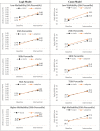The moderating impact of neighborhood walkability on mHealth interventions to increase moderate to vigorous physical activity for insufficiently active adults in a randomized trial
- PMID: 37582736
- PMCID: PMC10428579
- DOI: 10.1186/s12966-023-01494-2
The moderating impact of neighborhood walkability on mHealth interventions to increase moderate to vigorous physical activity for insufficiently active adults in a randomized trial
Abstract
Background: Ecological models suggest that interventions targeting specific behaviors are most effective when supported by the environment. This study prospectively examined the interactions between neighborhood walkability and an mHealth intervention in a large-scale, adequately powered trial to increase moderate-to-vigorous physical activity (MVPA).
Methods: Healthy, insufficiently active adults (N = 512) were recruited purposefully from census block groups ranked on walkability (high/low) and socioeconomic status (SES, high/low). Participants were block-randomized in groups of four to WalkIT Arizona, a 12-month, 2 × 2 factorial trial evaluating adaptive versus static goal setting and immediate versus delayed financial reinforcement delivered via text messages. Participants wore ActiGraph GT9X accelerometers daily for one year. After recruitment, a walkability index was calculated uniquely for every participant using a 500-m street network buffer. Generalized linear mixed-effects hurdle models tested for interactions between walkability, intervention components, and phase (baseline vs. intervention) on: (1) likelihood of any (versus no) MVPA and (2) daily MVPA minutes, after adjusting for accelerometer wear time, neighborhood SES, and calendar month. Neighborhood walkability was probed at 5th, 25th, 50th, 75th, and 95th percentiles to explore the full range of effects.
Results: Adaptive goal setting was more effective in increasing the likelihood of any MVPA and daily MVPA minutes, especially in lower walkable neighborhoods, while the magnitude of intervention effect declined as walkability increased. Immediate reinforcement showed a greater increase in any and daily MVPA compared to delayed reinforcement, especially relatively greater in higher walkable neighborhoods.
Conclusions: Results partially supported the synergy hypotheses between neighborhood walkability and PA interventions and suggest the potential of tailoring interventions to individuals' neighborhood characteristics.
Trial registration: Preregistered at clinicaltrials.gov (NCT02717663).
Keywords: Ecological models; Moderate-to-vigorous physical activity; Neighborhood walkability; Physical activity; mHealth intervention.
© 2023. BioMed Central Ltd., part of Springer Nature.
Conflict of interest statement
The authors declare that they have no competing interests” in this section.
Figures





Similar articles
-
The Association between Neighborhood Walkability and Physical Activity in a Behavioral Weight Loss Trial Testing the Addition of Remotely Delivered Feedback Messages to Self-Monitoring.Behav Med. 2024 Jul-Sep;50(3):232-241. doi: 10.1080/08964289.2023.2238102. Epub 2023 Jul 25. Behav Med. 2024. PMID: 37489802 Free PMC article. Clinical Trial.
-
Neighborhood Walkability Is Associated with Physical Activity and Prediabetes in a Behavioral Weight Loss Study: a Secondary Analysis.Int J Behav Med. 2023 Aug;30(4):486-496. doi: 10.1007/s12529-022-10112-7. Epub 2022 Jul 6. Int J Behav Med. 2023. PMID: 35794410 Free PMC article.
-
Rationale, design, and baseline characteristics of WalkIT Arizona: A factorial randomized trial testing adaptive goals and financial reinforcement to increase walking across higher and lower walkable neighborhoods.Contemp Clin Trials. 2019 Jun;81:87-101. doi: 10.1016/j.cct.2019.05.001. Epub 2019 May 4. Contemp Clin Trials. 2019. PMID: 31063868 Free PMC article. Clinical Trial.
-
Drugs for preventing postoperative nausea and vomiting in adults after general anaesthesia: a network meta-analysis.Cochrane Database Syst Rev. 2020 Oct 19;10(10):CD012859. doi: 10.1002/14651858.CD012859.pub2. Cochrane Database Syst Rev. 2020. PMID: 33075160 Free PMC article.
-
Falls prevention interventions for community-dwelling older adults: systematic review and meta-analysis of benefits, harms, and patient values and preferences.Syst Rev. 2024 Nov 26;13(1):289. doi: 10.1186/s13643-024-02681-3. Syst Rev. 2024. PMID: 39593159 Free PMC article.
Cited by
-
Exploring the Relationship between Built Environment Attributes and Physical Activity in Lower-Income Aging Adults: Preliminary Insights from a Multi-Level Trial.Int J Environ Res Public Health. 2024 May 9;21(5):607. doi: 10.3390/ijerph21050607. Int J Environ Res Public Health. 2024. PMID: 38791821 Free PMC article. Clinical Trial.
-
Just-in-Time Adaptive Interventions for Behavior Change in Physiological Health Outcomes and the Use Case for Knee Osteoarthritis: Systematic Review.J Med Internet Res. 2024 Sep 27;26:e54119. doi: 10.2196/54119. J Med Internet Res. 2024. PMID: 39331951 Free PMC article.
References
-
- Du Y, Liu B, Sun Y, Snetselaar LG, Wallace RB, Bao W. Trends in adherence to the physical activity guidelines for Americans for aerobic activity and time spent on sedentary behavior among US adults, 2007 to 2016. JAMA Netw open. 2019;2:e197597–7. doi: 10.1001/jamanetworkopen.2019.7597. - DOI - PMC - PubMed
-
- Hovell MF, Wahlgren DR, Adams MA. The logical and empirical basis for the Behavioral Ecological Model. In Emerging Theories in Health Promotion Practice and Research. Volume 2nd. Edited by DiClemente RJ. San Francisco: Jossey-Bass; 2009.
-
- Sallis JF, Owen N, Fisher E. Ecological models of health behavior. In Health Behavior and Health Education: Theory, Research, and Practice. Volume 4th. Edited by Glanz K, Rimer BK, Viswanath K. San Francisco: Jossey-Bass; 2009: 465–482.
Publication types
MeSH terms
Associated data
Grants and funding
LinkOut - more resources
Full Text Sources
Medical

